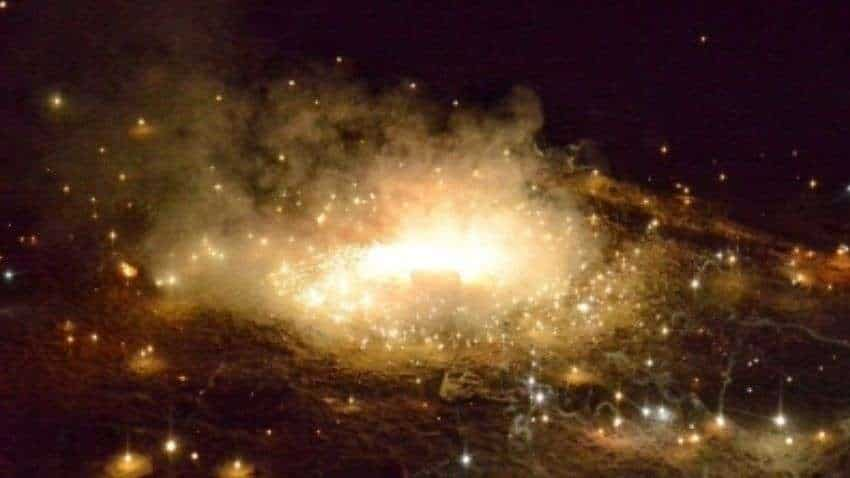Air Quality: Delhi-NCR residents wake up with itchy throat, watery eyes due to rampant cracker bursting on Diwali
A likely increase in fumes from farm fires on Friday may worsen the situation, authorities said.

Residents in many parts of Delhi-NCR woke up with an itchy throat and watery eyes as a thick layer of acrid smog engulfed the region on Friday following rampant cracker bursting on Diwali night.
A likely increase in fumes from farm fires on Friday may worsen the situation, authorities said.
WATCH | Click on Zee Business Live TV Streaming Below:
According to the Central Pollution Control Board (CPCB), the 24-hour average concentration of lung-damaging fine particles known as PM2.5 in Delhi-NCR shot up from 243 micrograms per cubic metre at 6 pm on Thursday (Diwali day) to 410 micrograms per cubic metre at 9 am on Friday, around seven times the safe limit of 60 micrograms per cubic metre.
The PM10 levels crossed the 500 micrograms per cubic metre mark around 5 am on Friday and stood at 511 micrograms per cubic metre at 9 am.
According to the Graded Response Action Plan (GRAP), the air quality is considered to be in the ?emergency? category if PM2.5 and PM10 levels continue to be above 300 micrograms per cubic metre and 500 micrograms per cubic metre, respectively, for 48 hours or more.
The air quality index (AQI) in Delhi shot up to 451 (severe) at 8 am as low temperature and fog in the morning allowed the accumulation of pollutants.
Fog conditions intensified in Delhi-NCR on Friday morning lowering visibility at the Indira Gandhi International Airport and the Safdarjung Airport to the range of 200 to 500 metres at 5:30 am. Visibility in parts of the city dropped to 200 metres,? said R K Jenamani, senior scientist at India Meteorological Department (IMD).
Of the 39 air quality monitoring stations in Delhi, 33 reported their AQI in the severe category.
The capital's air quality had entered the severe zone on Thursday night as people burst firecrackers on Diwali in a blatant disregard to the government's ban on it amid a sharp increase in smoke from farm fires.
The neighbouring cities of Faridabad (454), Greater Noida (410), Ghaziabad (438), Gurgaon (473) and Noida (456) recorded severe air quality on Friday morning.
An AQI between zero and 50 is considered good, 51 and 100 satisfactory, 101 and 200 moderate, 201 and 300 poor, 301 and 400 very poor, and 401 and 500 severe.
People from several parts of the capital and its suburbs complained of headache, itchy throat and watery eyes, as the thick layer of smog partially blotted out the sun in the morning.
Concerned citizens and environment activists shared pictures and videos of fireworks on social media and called the ban on crackers a ?joke?.
Delhi should ideally shut down tomorrow morning, and the government's cracker ban turned out to be a bigger joke this year. No one cares, meanwhile majority of my family is either down with severe dry cough or headaches.
#DelhiAQI is 700+ and the night hasn't even begun,? a Twitter user posted on the microblogging site.
People from a large number of areas in the capital had reported rampant cracker bursting on Thursday night, despite the blanket ban in the national capital till January 1, 2022.
Cracker bursting continued till late night in NCR cities of Noida, Faridabad and Gurugram.
The Haryana government had imposed a ban on the sale or use of all kinds of firecrackers in 14 of its districts in the National Capital Region.
The Uttar Pradesh government had allowed the use of green crackers on Diwali only for two hours in areas with moderate or better air quality.
Experts said the air quality turned severe owing to unfavourable meteorological conditions -- calm winds, low temperature and low mixing height -- and a poisonous cocktail of emissions from firecrackers, stubble burning and local sources.
The Ministry of Earth Sciences' air quality forecast agency SAFAR said the share of farm fires in Delhi's pollution rose to the season's highest at 25 per cent on Thursday and is expected to go up to 35 percent on Friday and 40 per cent on Saturday.
Relief is expected only from the evening of November 7 but AQI will fluctuate within the very poor range, the air quality forecast agency said.
Last year, the share of stubble burning in Delhi's pollution had peaked at 42 per cent on November 5. In 2019, crop residue burning accounted for 44 per cent of Delhi's PM2.5 pollution on November 1.
The contribution of stubble burning in Delhi's PM2.5 concentration was 32 per cent on Diwali day last year as compared to 19 per cent in 2019.
Get Latest Business News, Stock Market Updates and Videos; Check your tax outgo through Income Tax Calculator and save money through our Personal Finance coverage. Check Business Breaking News Live on Zee Business Twitter and Facebook. Subscribe on YouTube.
RECOMMENDED STORIES

Fundamental picks by brokerage: These 3 largecap, 2 midcap stocks can give up to 28% return - Check targets

SBI Senior Citizen Latest FD Rates: What senior citizens can get on Rs 7 lakh, Rs 14 lakh, and Rs 21 lakh investments in Amrit Vrishti, 1-, 3-, and 5-year fixed deposits

Tamil Nadu Weather Alert: Chennai may receive heavy rains; IMD issues yellow & orange alerts in these districts

SIP+SWP: Rs 10,000 monthly SIP for 20 years, Rs 25 lakh lump sum investment, then Rs 2.15 lakh monthly income for 25 years; see expert calculations

Top 7 Mutual Funds With Highest Returns in 10 Years: Rs 10 lakh investment in No 1 scheme has turned into Rs 79,46,160 in 10 years

SIP vs PPF: How much corpus you can build in 15 years by investing Rs 1.5 lakh per year? Understand through calculations

Retirement Planning: Investment Rs 20 lakh, retirement corpus goal Rs 3.40 crore; know how you can achieve it
01:33 PM IST










 Delhi air quality worsens to 'severe' category as smog chokes visibility
Delhi air quality worsens to 'severe' category as smog chokes visibility Delhi's pollution rise may see MCD double parking fees to curb emissions
Delhi's pollution rise may see MCD double parking fees to curb emissions Particulate matter from electric cars maybe 1,850 times higher than that from petrol or diesel vehicles: Study
Particulate matter from electric cars maybe 1,850 times higher than that from petrol or diesel vehicles: Study India tops global indoor air pollution chart with highest average annual PM2.5 levels: Study
India tops global indoor air pollution chart with highest average annual PM2.5 levels: Study  Delhi air pollution: Only electric, CNG, and BS VI-compliant diesel buses to operate between Delhi-NCR from November 1
Delhi air pollution: Only electric, CNG, and BS VI-compliant diesel buses to operate between Delhi-NCR from November 1